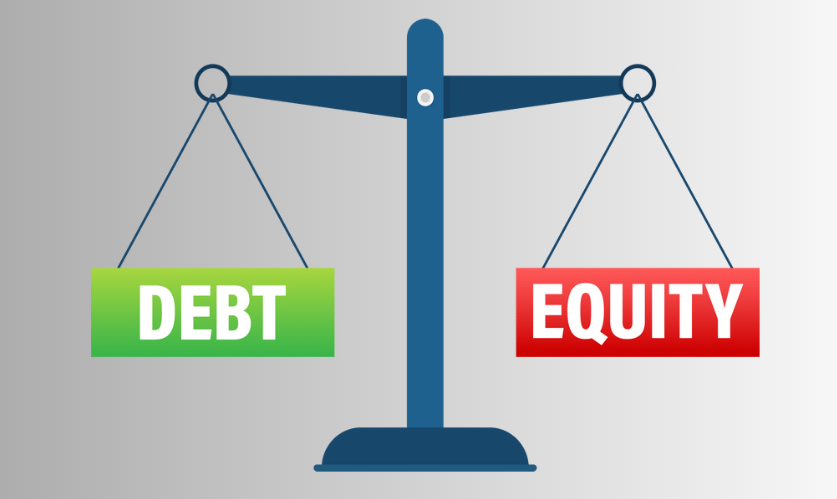The debt to equity ratio, usually written as D/E, is a financial ratio and is calculated by dividing the total debt of a company by the shareholder’s equity. It is a representative of the financing resources of the company i.e., debt and loans or personal resources and assets.
Further, there is the debt-to-capital (D/C) ratio and debt-to-capital employed ratio. These two are quite similar to the debt-to-equity ratio and hold notable importance in making financing decisions.
While the debt-to-capital ratio gives a proportional value between the total debt and total capital of a company, the debt-to-capital employed ratio provides a ratio between the total debt and employed capital (assets + working capital). Let us understand these ratios a little more.
Debt to Equity Ratio: Key Takeaways
- The debt to equity ratio (D/E) is used to assess the reliance of a company on debt. It is calculated by dividing the debt value by the equity value held by the shareholder(s).
- A high debt to equity ratio (D/E) is generally risky whereas a low debt-to-equity ratio is usually good provided other factors are financially stable as well.
- The debt to equity ratio may vary from industry to industry. They are of great significance in assessing market competition and comparing the company’s growth from its past position.
Understanding Debt to Equity Ratio (D/E)

The debt to equity ratio is a significant measurement value in finance, especially corporate finance. It defines a proportionate value between the liabilities owned by a company and the shareholder equity. Mainly, it is utilised to evaluate the financial leverage of a financial entity, company, or business.
The debt to equity ratio may vary from industry to industry and business to business. This is simply because it is a metric based on the balance sheet, which is different for different businesses and only shows the financial status of a business at a specific time. Given this, there is a variation in the D/E ratio of seasonal businesses based on the balance sheet preparation period.
In simple terms, the debt to equity ratio is a useful financial metric that reveals the project and operating finances of a company. It showcases whether those financial expenditures are funded by debt or its own resources and assets. Notably, the debt to equity ratio is a kind of gearing ratio. Let us learn how it is calculated in finance.
Also, Check What is the importance of Financial Institutions?
Formula of Debt to Equity Ratio (D/E) With Calculation
The formula used to calculate the debt-to-equity ratio is given as follows:
“Debt-to-Equity (D/E) Ratio = Total Liabilities / Total Shareholder’s Equity”
Both these values can be easily found on the balance sheet of a company. The shareholder’s equity, if not written directly on the balance sheet, can be calculated by subtracting the liabilities from the assets. So, it is:
Shareholder’s Equity = Assets – Liabilities
Thus, the shareholder’s equity shows how much part of the company is owned by another entity other than the company itself.
However, the exact debt to equity ratio may not be found as true values of liabilities and assets may not be there. For instance, the balance sheet may not have exclusive data about intangible assets, pension plan adjustments, financial losses, or retained earnings.
For a more appropriate debt to equity ratio, further research is a requirement. This is where we get modified D/E ratios which financial scientists also use to measure growth expectations and profitability by taking it in a way of short-term leverage ratios.
Meaning and Interpretation of Debt to Equity (D/E) Ratio
There are several things that the D/E ratio of a company puts forward. Here are the varied ways we can interpret the debt-to-equity ratio of a company to understand its financial standing and prospective growth expectations.
High Debt to Equity Ratio (D/E)
A high debt-to-equity ratio is an indicator that a company funds its financing operations mainly by debt which is very risky for the financial stability of a business. It can particularly cause problems during economic downturns as the company already has more debt to repay.
Low Debt to Equity Ratio (D/E)
A low debt-to-equity ratio suggests higher financial stability as it represents that the company is less reliant on debt or external borrowings.
Negative Debt to Equity (D/E) Ratio
A negative debt to equity ratio is the most risky of all since it presents the risk of bankruptcy or insolvency. However, it can also indicate that remarkable dividends were issued to shareholders by the company or simply, more equity was given to the shareholders.
Recommended Course
Significant Limitations of Debt-to-Equity (D/E) Ratio
The debt-to-equity ratio is a gearing ratio and has numerous uses in finance. Besides showcasing the growth or fall pattern of debt dependence of a company over a set period, it is used to understand market competition and analyse it for personal financial gains.
However, it has certain limitations as well. These are understood as follows:
Industry
A great concern when calculating the D/E ratio is the industry the concerned company belongs to. This is because there is a variation in the growth rates and capital demands of different industries.
For instance, capital-intensive companies such as utility stocks and consumer staples have a high D/E ratio. However, a high D/E ratio would not be considered as risky for them as would be for companies in some other industries.
This is because companies in slow-growth industries that have high leverage ratios make use of capital efficiently as they make large investments with steady return rates to generate stable income sources. They make heavy borrowings at relatively cheaper rates.
Also, Check, What is Risk Management in Finance?
The Definition of Debt

There is an inconsistency among financial experts about what is defined as debt. For instance, there is confusion about preferred stocks being debt or equity. They are considered as equity since they rank below debt in priority of claim on assets and preferred dividend payments are non-legal obligations. However, they seem more like debt because of liquidation rights and preferred dividend par value.
This makes it hard to calculate the D/E ratio for preferred stock financing industries such as REITs (Real Estate Investment Trusts). This is because the ratio will look riskier if preferred stocks are taken as debt and the ratio would be too low if they are considered equity.
What does the Debt to Capital Ratio (D/C) mean?
The debt to capital (D/C) is a common financial metric used to measure the capital structure, financial leverage, and solvency of a company. A simple way to calculate the debt-to-capital ratio is to divide the total debt of the company by its total capital. The total capital is given by the sum of the company’s debt and equity.
Here is the formula to calculate the debt to capital (D/C) ratio:
“Debt to Capital (D/C) Ratio = Total Debt / Total Capitalization”
While calculating the debt-to-capital ratio of a company, it is important to consider a few things. These are as provided below:
- Age of the Company: Make a consideration about the age of the company when calculating the debt-to-capital (D/C) ratio.
- Type of Industry: The type of industry a company belongs to is an important entity to consider for D/C ratio calculation. This is because some industries such as consumer staples, banking, and utilities, etc. generally have a high debt to equity ratio which provides that these industries also possess a high debt value.
- Accounting Practices: Accounting practices also affect the calculation of the D/C ratio. For instance, financial statements that are based on historical cost accounting may not be an accurate representation of the present financial leverage of the company.
A high debt-to-capital ratio is indicative of a greater probability of financial default. This is because a high D/C ratio shows that the total debt value of the company is much higher than the total capital of the company which means the company may not be able to cover its liabilities and debt from its earnings.
However, this may not be the exact case in all industries. The consideration of a reasonable and appropriate debt to capital ratio is also dependent upon the type of industry, as certain sectors utilise more leverage than others.
Debt to Capital Employed Ratio
The debt-to-capital employed ratio refers to a type of accounting ratio which is used to get insights into the financial structure of a company and find out about its financing capabilities. It compares the total long-term debt value of a company to its capital employed. Here, the capital employed value is found by adding the fixed assets of the company to its working capital.
The formula for calculating the debt-to-capital employed ratio is as follows:
“Debt to Capital Employed Ratio = Long-term Debt / Value of Capital Employed (Net Assets)”
Let us look into some of the things that the debt-to-capital employed ratio indicates.
- Debt Proportion: Similar to the debt-to-equity (D/E) ratio and the debt-to-capital (D/C) ratio, the debt-to-capital employed ratio indicates the amount of debt used to finance the operations of a company.
- Investment Value and Assessment: The debt-to-capital employed ratio is vital for investors as it helps them learn about the financial structure of the company and assess if or not it would be a good investment.
- High Risk on a High Value: A high debt-to-capital employed ratio indicates a greater risk of default on the company’s part as it means that a larger part of the company’s financing is done through debt and not equity. This is not good for the financial stability of the company.
- Economic Stability and Leverage: The debt-to-capital employed ratio provides insight into the leverage of the company and its financial stability.
Learn Financial Modeling and Taxation with PW Skills
If you are interested in making a career in finance then enroll in our Finance Modeling and Taxation Course to get in-depth learning of finance and accounting, financial modeling, and the tax system in India.
This 4-month online upskilling course is powered by PwC India and is made based on industry-driven curriculum. You will get to work on advanced tools under the guidance of experienced mentors. Get real-world scenarios from PwC India and much more only at pwskills.com
Debt to Equity Ratio FAQs
Q1. What industries show a high D/E ratio?
Ans: The financial services sector, airlines, industrials and banking industries generally have a high debt-to-equity (D/E) ratio. Capital-intensive industries have a high D/E ratio as they have high debt or total liabilities value.
Q2. What does the D/E ratio of 1.5 mean?
Ans: A D/E ratio of 1.5 means that the company has a debt value of 1.5 for every 1 value of equity and also that the debt value is greater than the equity value. It is a standard manner to finance the company.
Q3. What does the debt to capital ratio tell?
Ans: The debt-to-capital (D/C) ratio tells the proportionate debt value a financial entity such as a company uses to fund its assets concerning the equity amount used for the same aim.
Q4. What is a good debt-to-working capital ratio?
Ans. Generally, values between 1.5 and 2 are considered good for debt-to-working capital ratios. It shows that the debt value is enough to fund necessary operations of the company and at the same time they are not exceeding the capital value so much as to lead to a default.

